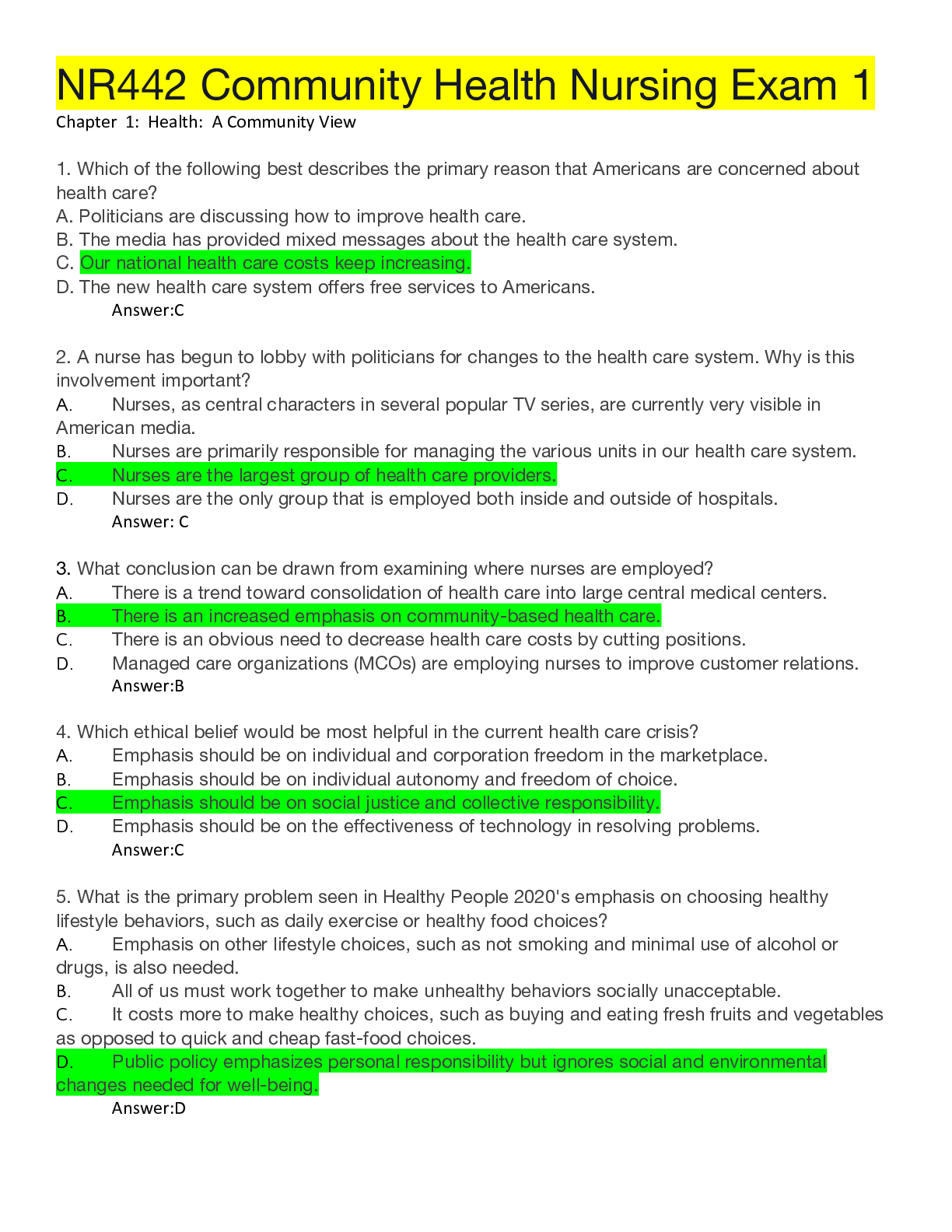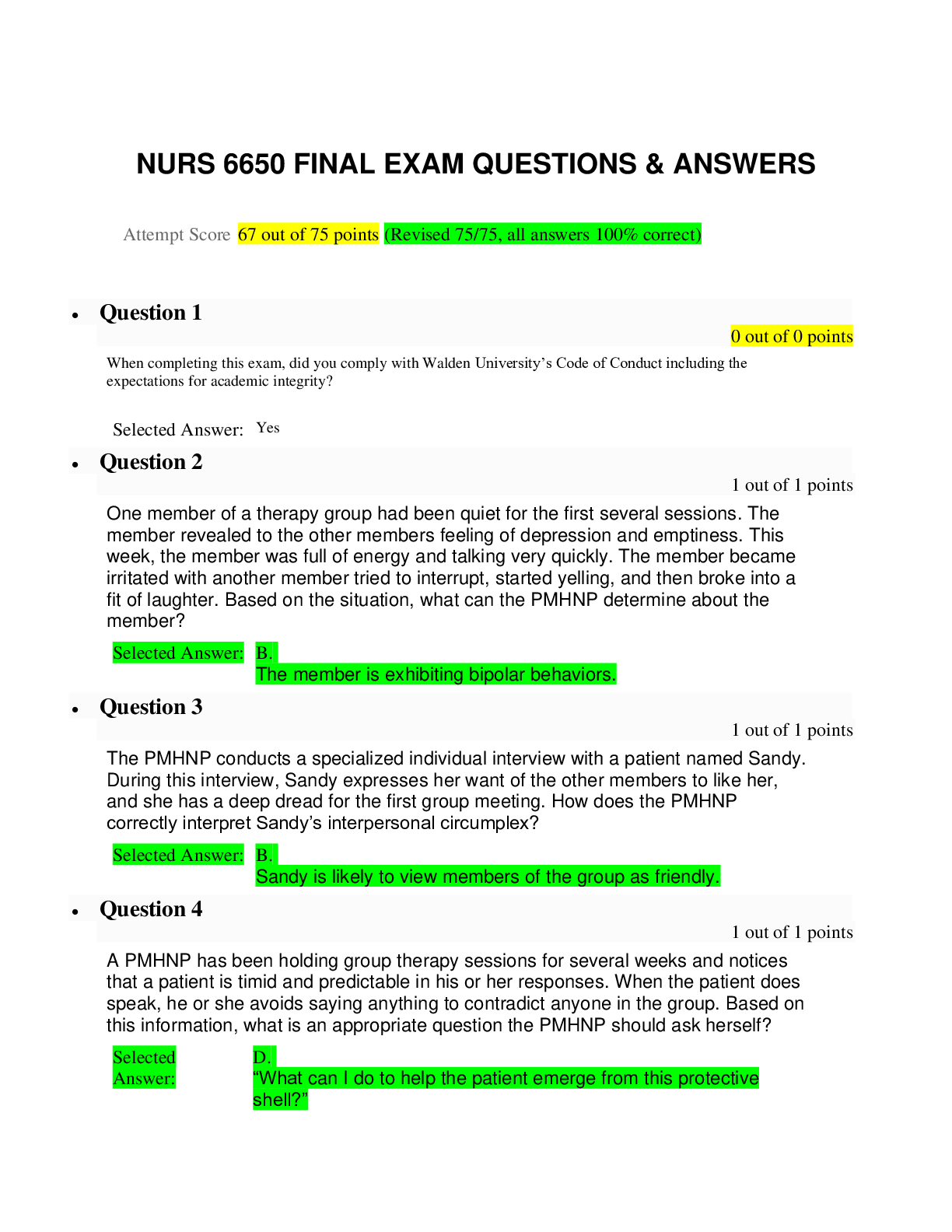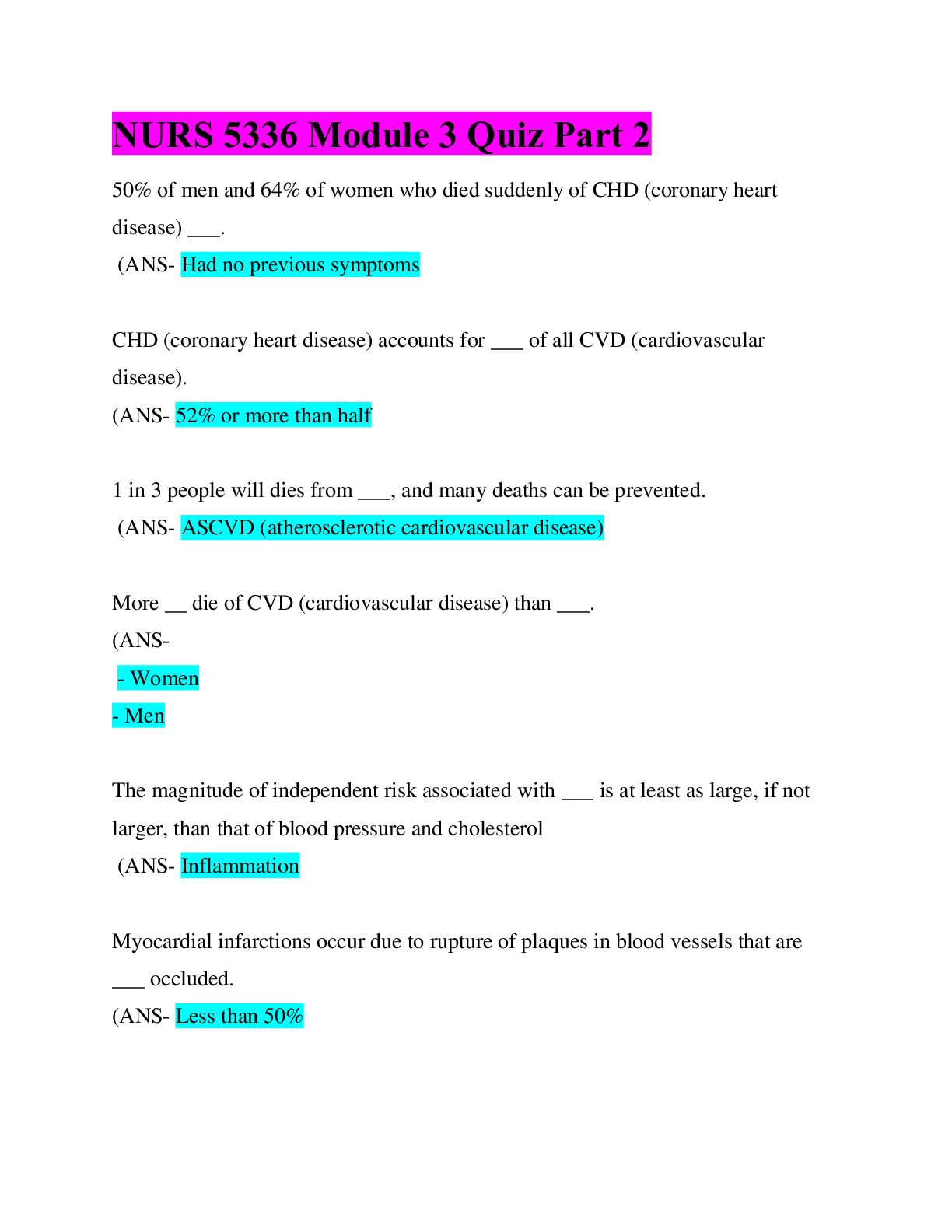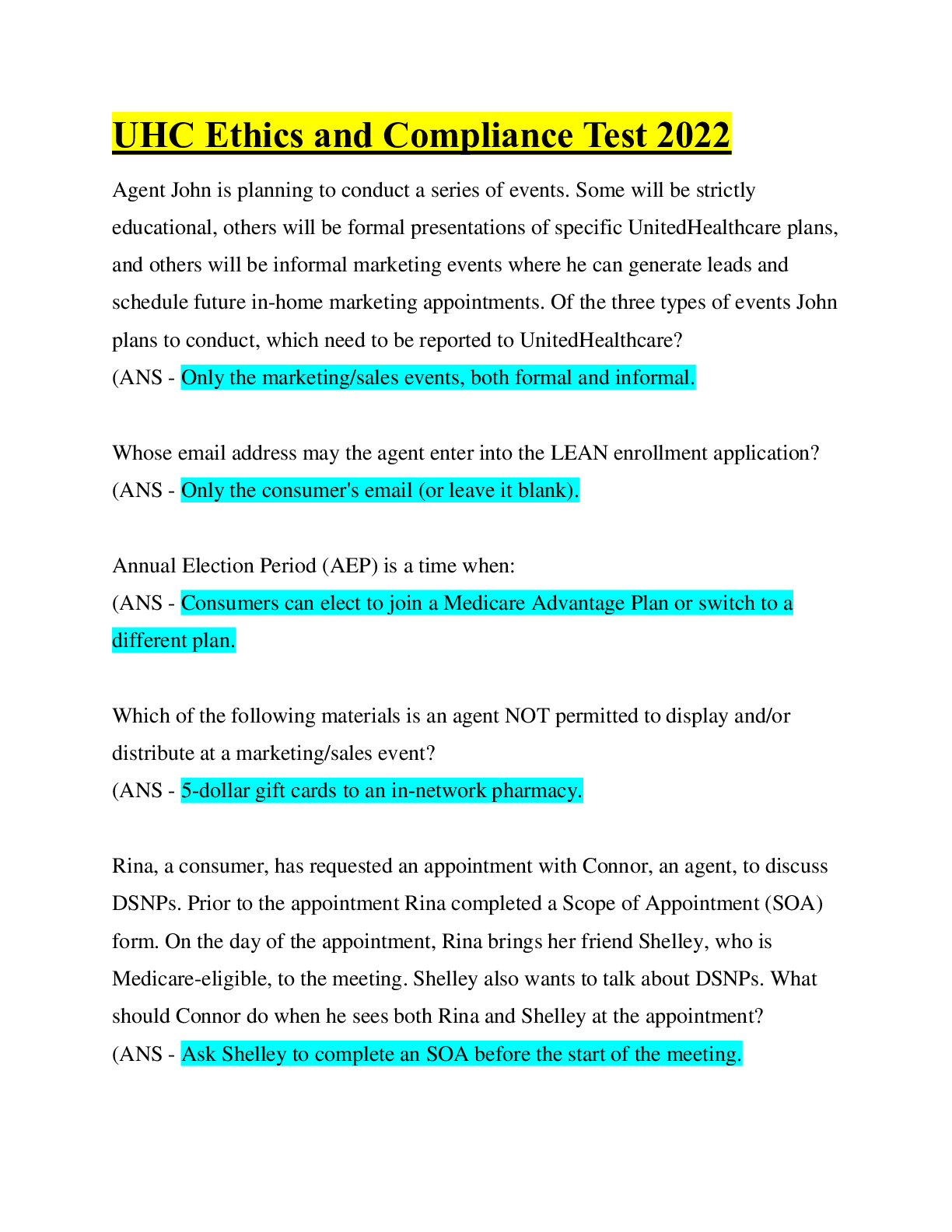NUR 396 maternal Test 1 Questions & Answers Latest 2021/2022,100%CORRECT
Document Content and Description Below
NUR 396 maternal Test 1 Questions & Answers Latest 2021/2022 Ch. 3 Care at specific stages of a woman’s life • Preconception counseling and care provides woman and partners with information ... that is needed to make decisions about reproductive future. • Pregnancy early entry into prenatal care allows identification of the woman at risk for complications and initiation of measures to prevent problems or treat them if they arise. Define health status of mother and fetus • Fertility control More than half of pregnancies are unintended and majority do not use contraception or experienced a failure in contraception • Infertility can cause emotional pain for some families and inability to produce offspring may come as a sense of failure • Menstrual problems Irregularities or problems with menstrual are common reasons women seek care from provider. History along with diagnostic tests need to be done • Perimenopause Body responds to this in a variety of ways. Hot flashes or irregular bleeding cause women to seek care. Still need some sort of birth control as pregnancy can still happen Identification of Risk Factors • Social, cultural, genetic ▪ ie: sickle cell anemia in A.A., Tay- Sachs disease in Ashkenazi Jews, Cystic fibrosis in Northern Europeans ▪ Cultural and religious influences ▪ Socioeconomic status- the rates of perinatal and maternal deaths, preterm births, and low birth weight babies are considerably higher in disadvantaged populations • Substance use and abuse o Prescription drug use- 2% of American women use sleeping pills, tranquilizers and pain relievers. o Illicit drug use ▪ Marijuana- crosses the placenta- reduces O2 supply to fetus ▪ Cocaine- causes vasoconstriction- increases incidence of miscarriage, preterm labor, small for gestational age, Abruptio placenta, still birth, anomalies ▪ Opiates- Heroin, morphine, codeine, methadone. Women have a 6X higher risk for problem outcomes ▪ Methamphetamine- CNS stimulant-meth, speed- heart problems, irregular heart beat and hypertension- preterm birth, Intra Uterine Growth Restriction with smaller head circumference ▪ PCP-major concern in pregnant women is its association with polydrug use and neurobehavioral effects on the neonate. o Alcohol consumption- ▪ About 1/3 of alcoholics are women ▪ FAS ~ 40,000 babies born, low birth weight, behavioral problems, intellectual disability o Cigarette smoking- ▪ Causes vasoconstriction, decrease in placental perfusion and is one cause of low birth weight o Caffeine- increase risk of miscarriage- March of Dimes recommends no more than 8 oz of caffeine drink/day • Stress ▪ can trigger physical reactions such as rapid HR, elevated BP also other flare-ups. Nurse needs to use effecting communication skills to see if need for further mental illness • Mental health conditions • Sleep disorders ▪ women more than men and nurse discuss sleep patterns and ways to improve them • Environmental and work place hazards ▪ Hazards can affect fertility, fetal development, live birth, and childs future mental and physical development • Risky sexual practices ▪ STI’s • Risk for certain medical or gynecologic conditions • Female genital mutilation Violence against Women • Intimate partner violence (IPV) ▪ IPV is the most common form of violence experienced by women worldwide with a reported incidence of 1 in 6 women being a victim of domestic violence o Physical or emotional abuse o Sexual assault o Isolation o Controlling all aspects of the woman’s life ▪ Money, shelter, time, and food • Cycle of violence o Phase 1: Tension building ▪ That her experiences increased tension, victim minimizes problems ▪ Tension becomes intolerable o Phase 2: Abusive incident ▪ Batterer highly abusive, incident occurs o Phase 3: Honeymoon period ▪ Loving, apologetic, promises change • Battering during pregnancy o Rates range from 4% to 8% and may be as high as 20% in some populations o Incidence of intimate partner violence may escalate o May happen for the first time during pregnancy o Risk to the fetus includes increased rate of miscarriage, preterm birth, and stillbirth o Screening intimate partner violence- (Box 3-10- Signs of IPV) ▪ Patient should be interviewed alone ▪ Look for unexplainable or untreated injuries – various parts of the body and different stages of healing. ▪ Injuries that don’t match the description Assessment of the Woman • Interview- routine history and physical • Ways to encourage sharing information • Facilitation- using a word or posture that communicates interest • Reflection- repeating a word or phrase that a woman has used • Clarification- asking the woman what is meant by a stated word or phrase • Empathic responses- acknowledging the feelings of a woman • Confrontation- identifying something about the woman’s behavior or feelings not expressed verbally or inconsistent with history • Interpretation- Put into words what you infer about the woman’s feelings • History o Biographic data o Reason for seeking care o Present health or history of present illness o Past health o Family history o Screen for abuse o Review of systems o Functional assessment • Physical examination o General appearance- age, race, sex, ht, wt, state of health, hygiene o Vital signs- temp, pulse, respiration, BP o Objective data is recorded by body systems- skin, HEENT, body o Findings are described in detail • Cultural considerations and communication variations o Trust that woman is expert on her life, culture, and experiences o If asked with respect and genuine desire to learn, woman will tell nurse how to care for her o May be considered inappropriate for woman to disrobe completely for physical examination o In many cultures a female examiner is preferred • Women with special needs o Women with disabilities ▪ Emotional or physical disorders ▪ Vision or hearing impaired ▪ Adapt to each woman’s needs o Adolescents (ages 13 to 19 years old) ▪ Risky sexual behaviors ▪ Eating disorders ▪ Safety • Pelvic examination • Laboratory and diagnostic procedures o The following laboratory and diagnostic procedures are ordered at discretion of clinician: see next slide o Results of these tests may be reported in person, by phone call, or by letter Health Screening for Women • Hemoglobin • Fasting blood glucose • Total blood cholesterol • Lipid profile • Urinalysis • Syphilis serology (VDRL or RPR) and other screening tests for sexually transmitted infections • Mammogram • Tuberculosis skin testing • Hearing • Visual acuity • Electrocardiogram • Chest x-ray • Pulmonary function • Fecal occult blood • Flexible sigmoidoscopy • Bone mineral density (DEXA scan) ➢ Laboratory and diagnostic procedures • Tests for human immunodeficiency virus and hepatitis B and drug screening may be offered with informed consent in high risk populations Ch. 4 Reproductive system concerns • Amenorrhea- the absence of menstrual flow o Primary ▪ Anatomic ▪ Endocrine- hypo/hyper thyroidism ▪ Chronic disease- Type 1 diabetes ▪ Eating disorders-anorexia ▪ Medications- Dilantin, illicit drug use ▪ strenuous exercise, emotional stress and OC use o Secondary ▪ Most often result of pregnancy A= without, Dys= pain • Hypogonadotropic amenorrhea o Problem in central hypothalamic-pituitary axis o Results from hypothalamic suppression -as a result of stress • Management-many of the causes are potentially reversible o Counseling and education regarding stress, exercise, and weight loss o Calcium, vitamin D -research is inconclusive-used for female athlete triad • Dysmenorrhea o Pain during or shortly before menstruation o Primary dysmenorrhea-associated with ovulatory cycles ▪ Biochemical basis ▪ Arises from the release of prostaglandins ▪ Abnormally increased uterine activity ▪ Alleviating discomfort • Medications- NSAIDS- best if started several days before onset • Heat- Heating pad or hot bath minimizes cramping by increasing vasodilation and muscle relaxation • Massaging lower back • Alternative modalities-Yoga, acupuncture, meditation, herbal therapy • Dysmenorrhea o Secondary dysmenorrhea- typically after age 25 ▪ Acquired menstrual pain associated with pelvic pathology • endometriosis, PID, endometrial polyps or fibroids ▪ Diagnosis and treatment • Pelvic examination • Ultrasound examination, dilation and curettage, endometrial biopsy, laparoscopy • Treatment directed to removal of underlying pathology • Premenstrual syndrome (PMS)-“I feel irritable and moody a week before my period is supposed to start” o Cyclic symptoms occurring in luteal phase of menstrual cycle ▪ PMS • Cluster of physical, psychological, and behavioral symptoms • Poorly understood • 30% to 80% of women experience mood or somatic symptoms • Treatment includes diet, exercise, and herbal therapies (Calcium and B6) (Natural diuretics) • Premenstrual dysphoric disorder (PMDD) o Cyclic symptoms occurring in the last 7 to 10 days of the menstrual cycle ▪ PMDD • Severe variant of PMS with emphasis on mood affectation • Affects 3% to 8% of women • Treatment similar to that for PMS; plus may warrant counseling, medications, and alternative therapies, such as hypnosis and acupuncture • Endometriosis o Presence and growth of endometrial tissue outside of uterus-May be on the ovaries round ligaments, colon, appendix…. o Endometrial tissues contains glands and stoma and responds to cyclic hormone stimulation. During menstruation the tissue bleeds, resulting in fibrosis and adhesions. o May worsen with repeated cycles or remain asymptomatic & disappear after menopause o Major symptoms ▪ Dysmenorrhea (pain during menstruation) ▪ Deep pelvic dyspareunia (painful intercourse) o Treatment ▪ Drug therapy ▪ Surgical intervention • Alterations in cyclic bleeding o Oligomenorrhea- infrequent Infections o hypomenorrhea- scanty at normal intervals o Menorrhagia (hypermenorrhea)- excessive o Metrorrhagia-occurs between periods o Abnormal uterine bleeding- AUB-any form of uterine bleeding that is irregular in amount, duration, or timing and is not related to regular menstrual bleeding o Dysfunctional uterine bleeding-DUB- most commonly caused by anovulation. ie; PCOS • Sexually transmitted infections (STIs) o Includes more than 25 infectious organisms transmitted sexually (Box 4-2) o 19 million people affected annually in the U.S. o Prevention ▪ Primary-preventing infection ▪ Secondary- Prompt diagnosis and treatment • STIs/HIV prevention strategies o Safer sex practices ▪ Knowledge of partner, reducing partners ▪ Low-risk sex ▪ Condom use ▪ Vaccination- HPV, Hep A&B • Sexually transmitted bacterial infections o Chlamydia ▪ Most frequently reported STI ▪ Infections often silent and highly destructive ▪ Difficult to diagnose- asymptomatic,although some women experience spotting or post coital discharge, mucoid or purulent o Screening and diagnosis ▪ Screening of asymptomatic and pregnant women ▪ Comparisons of diagnostic procedures o Management ▪ Drug therapy- Azithromycin • Sexually transmitted bacterial infections o Gonorrhea – Neisseria gonorrhoeae ▪ Oldest communicable disease- exclusively transmitted by sexual contact ▪ Aerobic and gram-negative diplococci o Screening and diagnosis ▪ Women are often asymptomatic o Management ▪ Treatment with antibiotic therapy- Ceftriaxone ▪ Drug-resistant strains on the rise • Sexually transmitted bacterial infections o Syphilis - Treponema pallidum, a motile spirochete ▪ Transmission by entry in subcutaneous tissue through microscopic abrasions ▪ Transplacental transmission may occur at any time during pregnancy ▪ Infection manifests itself in distinct stages • Primary: 5 to 90 days • Secondary: 6 weeks to 6 months • Sexually transmitted bacterial infections o Syphilis ▪ Screening and diagnosis • Pregnant women • Serologic tests- nontreponemal and treponemal • False positives ▪ Management • Penicillin • Sexual abstinence during treatment • Sexually transmitted bacterial infections o Pelvic inflammatory disease (PID) ▪ Results from ascending spread of microorganisms from vagina and endocervix to upper genital tract ▪ Caused by multiple organisms ▪ Most commonly involves: • Uterine tubes (salpingitis) • Uterus (endometriosis) • Sexually transmitted bacterial infections o PID- Chlamydia is estimated to cause one half of all cases o At increased risk for: • Ectopic pregnancy • Infertility • Chronic pelvic pain ▪ Symptoms depend on type of infections: • Acute- sever, persistent • Subacute- dull, cramping, intermittent • Chronic o PID ▪ Screening and diagnosis • History • CDC routine criteria ▪ Management • Prevention counseling- avoiding contracting STI’s • Oral or parenteral therapy (ie: ceftriaxone+ Doxycycline+ metronidazole) • Bedrest • Education • Sexually transmitted viral infections o Human papillomavirus (HPV) ▪ Most prevalent viral STI seen in ambulatory health care settings ▪ STI that may lead to cervical cancer ▪ Genital warts ▪ More common in pregnant women o Symptoms ▪ Irritating vaginal discharge with itching ▪ Dyspareunia, postcoital bleeding o HPV ▪ Screening and diagnosis • History of known exposure • Physical inspection • Pap smear- likely to cause cancer ▪ Management • No therapy has been show to eradicate • Medications for discomfort • Counseling and education • Sexually transmitted viral infections o Herpes simplex virus (HSV) ▪ Herpes simplex virus 1 (HSV-1) • Transmitted nonsexually ▪ Herpes simplex virus 2 (HSV-2) • Transmitted sexually • neither type is exclusively associated with the respective sites • Sexually transmitted viral infections o HSV ▪ Initial infection is characterized by multiple painful lesions, fever, chills, malaise, and severe dysuria • Maternal infection can have adverse effects on both the mother and fetus • Increased miscarriage rates during the first trimester • Association with cervical cancer has been observed • Prevention is critical! o Viral hepatitis ▪ Hepatitis A virus (HAV) • Acquired primarily through fecal-oral route • Ingestion of contaminated food • Person to person contact • Vaccination is most effective means of preventing HAV transmission o Viral hepatitis ▪ Hepatitis B virus • Most threatening to fetus and neonate • Disease of liver; often a silent infection • Transmitted parenterally, perinatally, orally (rarely), and through intimate contact • Vaccination series ▪ Hepatitis C virus • Most common blood-borne infection in United States • Risk factor for pregnant women is history of injecting intravenous drugs • Currently there is no vaccine o Human immunodeficiency virus (HIV) ▪ Heterosexual transmission now most common means of transmission in women ▪ Estimated that 23% of new infections occur in women ▪ Transmission of HIV occurs primarily through exchange of body fluids o HIV o HIV ▪ Severe depression of cellular immune system associated with HIV infection characterizes AIDS ▪ Symptoms include fever, headache, night sweats, malaise, generalized lymphadenopathy, myalgias, nausea, diarrhea, weight loss, sore throat, and rash ▪ Screening and diagnosis • Antibody testing- test most labs focus on • CDC advocates routine voluntary testing ▪ Counseling for HIV testing • HIV testing offered early in pregnancy • Rapid testing preferred method • Perinatal transmission has decreased • Nurses must consider confidentiality and documentation o HIV management ▪ Resources • Death and dying • Suicide prevention • Financial assistance • Legal advocacy ▪ Prevention of transmission and receipt of contraceptive information • Substance abuse programs • Vaginal infections o Vaginitis ▪ An infection caused by a microorganism ▪ Also called abnormal vaginal discharge o Bacterial vaginosis syndrome in which normal hydrogen peroxide-producing lactobacilli are replaced with high concentrations of anaerobic bacteria ▪ Associated with preterm labor and birth ▪ most common type of vaginal infection ▪ findings, profuse, thin, grayish white vaginal discharge with a “fishy odor” • Vaginal infections o Candidiasis – Candida albicans ▪ Vulvovaginal candidiasis, or yeast infection, is second most common type of vaginal infection ▪ Predisposition • Antibiotic therapy • Diabetes • Pregnancy • Obesity • Diets high in refined sugars • Use of corticosteroids • Immunosuppressed states • Vaginal infections o Candidiasis or Yeast infection o Common symptoms ▪ Vulvar • Vaginal pruritus • thick, white, lumpy , cottage cheese like discharge o Screening and diagnosis ▪ Physical examination ▪ Vaginal pH o Management ▪ Over-the-counter agents- miconazole (Monostat) ▪ Methods of comfort- sitz bath, full course of treatment • Vaginal infections o Trichomoniasis – Trichomonas vaginalis- caused by an anaerobic, one- celled protozoan with characteristic flagella. ▪ STIs ▪ Common cause of vaginal infection ▪ Screening and diagnosis • Specular examination- o may be symptomatic, women may experience yellow green, frothy, mucopurulent, copious, malodorous discharge. o “strawberry spots” on cervix • Pap smear ▪ Management • Metronidazole or tinidazole orally in a single dose • Sexual transmission must be communicated to infected woman. The organism can be present without symptoms, perhaps for several months. • Vaginal infections o Group B streptococci- may be considered normal vaginal flora in non pregnant women, o Associated with poor pregnancy outcomes ▪ An important factor in neonatal morbidity and mortality • risk factors include preterm birth • intrapartum maternal fever higher than 100.4 ▪ Screening at 35 to 37 weeks of gestation decreases risk Infection Control • Infection control measures essential to protect care providers and prevent nosocomial infection of patients, regardless of infectious agent • Risk for occupational transmission varies with disease • Any risk warrants reasonable precautions • Standard Precautions Problems of the Breast • Benign problems o Fibrocystic changes -lumpiness with or without tenderness in both breasts o Fibroadenoma- single most common type of tumor seen in adolescent population- also in women in their 30’s o Nipple discharge o Mammary duct ectasia- inflammation of ducts behind the nipple o Intraductal papilloma- inflammation within the terminal nipple ducts- rare • Cancer of the breast-The exact cause of breast cancer is unknown o Incidence and etiologies ▪ One in eight women ▪ Risk increases with age o Prevention ▪ Chemotherapy prevention o Screening ▪ Mammography ▪ Needle aspiration- confirms a suspected diagnosis of breast cancer • Cancer of the breast • Medical management o Radiation- f/u for stage I or II- external for3-6 weeks o Adjuvant hormone therapy- tamoxifen used for women over 50 for at least 5 years- may cause nausea, hot flashes, and vaginal bleeding o Biologic targeted therapy- is a cancer treatment that restores or boosts the body’s own immune system to stop or slow the growth of cancer cells and keep cancer from spreading o Chemotherapy-is often given to premenopausal women who have positive nodes • Cancer of the breast o Surgical management- (remember to never put BP cuff on the affected arm) ▪ Lumpectomy- removal of tumor and small amount of surrounding tissue. ▪ Total simple mastectomy- removal of breast containing tumor ▪ Modified radical mastectomy- removal of breast tissue, skin, and fascia of the pectorals and dissection of the axillary nodes. ▪ Radical mastectomy- rarely performed- removal of breast, pectorals, complete axillary node dissection. then radiation, chemo, or hormone therapy ▪ Breast reconstruction- Ch. 5 Infertility, Contraception, and abortion Infertility • Incidence o Affects about 10% to 15% of reproductive-age couples o diagnosis for couples who have not achieved pregnancy after 1 year of regular, unprotected intercourse when the women is less than 35 yrs or after 6 months when the women is older than 35. o Four goals when providing care: ▪ Provide the couple with accurate information ▪ Assist in identifying the cause of infertility ▪ Provide emotional support ▪ Guide and educate about forms of treatment • Assessment of female infertility (Box 5-1) o Ovarian factors ▪ developmental anomalies ▪ anovulation ▪ medications o Tubal and peritoneal factors ▪ developmental anomalies of the tubes fig 5-1 ▪ reduced tubal motility ▪ tubal adhesions ▪ endometriosis o Uterine factors ▪ anomalies ▪ fibroid tumors ▪ Asherman’s syndrome (uterine adhesions or scar tissue) o Vaginal-cervical factors ▪ infections ▪ cervical mucous inadequate ▪ development of sperm antibodies o Other factors ▪ nutritional deficiencies ▪ obesity ▪ thyroid dysfunction • Assessment of male infertility- semen analysis (Box5-6) o Hormonal factors- testosterone, gonadotropin, FSH, and LH o Testicular factors- check for abnormalities o Factors associated with sperm transport o Idiopathic male infertility Care Management • Assessment of female infertility 1 year of regular intercourse or 6 months if over age of 35 o Test or examination ▪ Evaluation of the anatomy ▪ Detection of ovulation ▪ Hormone analysis ▪ Ultrasonography ▪ Endometrial biopsy ▪ Hysterosalpingography- checks for tubal blockages Fig 5-2 ▪ Laparoscopy fig 5-3 • Assessment of male infertility o Semen analysis- smoking can reduce the quality of the sperm o Hormone analysis- testosterone, LH, gonadotropin o Scrotal ultrasound- presence of varicoceles and any abnormalities • Plan of care and implementation o Psychosocial considerations o Nonmedical treatments ▪ Herbal alternative methods o Medical therapy o Surgical therapies ▪ Assisted reproductive therapies (ART) • Assisted reproductive therapies (Table 5-2) o In vitro fertilization–embryo transfer (IVF-ET) o Gamete intrafallopian transfer (GIFT) o Zygote intrafallopian transfer (ZIFT) o Ovum transfer (oocyte donation) o Therapeutic donor insemination (TDI) o Embryo hosting o Assisted embryo hatching • Reproductive alternatives o Surrogacy o Preimplantation genetic diagnosis o Adoption o Cryopreservation of human embryos Contraception • Intentional prevention of pregnancy • Birth control is the device or practice to decrease the risk of conceiving • Family planning is the conscious decision on when to conceive or avoid pregnancy • May still be at risk for pregnancy • Nearly half of all U.S. pregnancies are unplanned • A multidisciplinary approach to assist the woman in choosing an appropriate contraceptive method • Ideally the method should be safe, readily available, economical, acceptable, and simple to use • Contraceptive choice must meet personal, social, cultural, and interpersonal needs Methods of Contraception • Coitus interruptus (withdrawal) 27% unintended pregnancy • Fertility awareness methods (FAMs) 24% failure rate o Rely on avoidance of intercourse during fertile periods o FAMs combine charting menstrual cycle with abstinence or other contraceptive methods o Natural family planning (period abstinence) o Calendar rhythm method • FAMs – Fertility awareness Methods o Standard days method o Basal body temperature method o Cervical mucus ovulation-detection method o Symptothermal method o Predictor test kits for ovulation o TwoDay method o Breast-feeding • Barrier methods o sSpermicides- reduces mobility of sperm- 29% failure rate o Condoms, male (STI protection) 18% failure rate o Vaginal sheath (STI protection) non-latex -21% failure rate o Diaphragm- dome shaped latex or silicone used with spermicide- must be fitted -12% fail rate o Cervical cap- made of silicone rubber- use with spermicide- remains in place 6-48 hours- less effective than diaphragm o Contraceptive sponge- small round sponge containing spermicide- provides coverage up to 24 hoursfailurge rate is greater than the diaphragm • Hormonal methods o Combined estrogen-progestin contraceptives (COCs) ▪ Oral contraceptives and side effects- effectiveness can be altered by some over the counter medications and herbal supplements ▪ Transdermal contraceptive system ▪ Vaginal ring • Hormonal methods o Progestin-only contraceptives - lactating women ▪ Oral progestins (minipill)- less effective bc of low dose of progestin- same time every day- ▪ Injectable progestins- Depo-Provera- every 11-13 wks ▪ Implantable progestins (Norplant)- small tube or rod inserted under the skin- 3 yrs • Emergency contraception o Used within 72 hours of unprotected intercourse o Five methods available in the United States ▪ High doses of estrogen or COCs (three options) ▪ Two days of levonorgestrel ▪ Insertion of the copper intrauterine device (IUD) Abortions • IUD o Small, T-shaped device wrapped in copper inserted into the uterine cavity(Paragard) failure rate 0.8%- copper acts as a spermicide- inflames the endometrium- 10 years o Medicated intrauterine system loaded with progestational agent (Mirena)- impairs sperm motility- 5 years- failure rate 0.2% o IUD offers no protection against STIs or HIV o increased risk of PID also risk of perforation • Sterilization o Female 0.5% failure rate ▪ Tubal occlusion ▪ Tubal reconstruction o Male (vasectomy) 0.15% failure rate ▪ Tubal reconstruction (reanastomosis) fertility rate only 50% • Purposeful interruption of pregnancy before 20 weeks of gestation o Elective o Therapeutic • Contributing factors • Legal and moral issues o Roe v. Wade 1973 • First-trimester abortion less than 9 weeks o Surgical (aspiration) abortion (vacuum or suction curettage) o Medical abortion 17% of reported abortions in 2008 US ▪ Methotrexate and misoprostol ▪ Mifepristone and misoprostol • Second-trimester abortion 10% percent performed 2nd trimester- up to 20 weeks gestation o Dilation and evacuation o Cervical preparation with prostaglandins o Emotional considerations o disadvantages include possible long term harmful effects on the cervix. • Induced abortion performed in the first trimester is safest and less complex • Common complications: o Infection o Retained products of conception o Excessive vaginal bleeding Ch. 6 Genetics, conception and fetal development • Provides the tools to determine the hereditary component of many diseases • Improves our ability to predict susceptibility, onset, progression, and response to treatment • Genetic disease affects all people • Expanded roles for nurses with expertise in genetics and genomics are developing in areas of maternity and women’s health • Preconception counseling and testing • Neonatal genetic screening and testing • Palliative care for infants with life-threatening conditions • The identification and care of individuals with genetic conditions • Specialized care of women with genetic conditions during pregnancy • Congenital heart disease • Cystic fibrosis • Factor V Leiden • Essential Nursing Competencies Guidelines for Genetics and Genomics • Collects family history information • Develops plan of care that incorporates genetics assessment • Provides patients with genetic information, resources, and services • Facilitates referrals for specialized services • Evaluates the impact and effectiveness of genetic and genomic technology, interventions, and treatments Human Genome Project • The human genome is the complete set of genetic instructions in the nucleus of each human cell. • Two key findings of the project were 1. All human beings are 99.9% identical at the DNA level 2. There are approximately 20,000 genes in the human genome • Genetic testing • Prenatal tests- maternal serum screening- increased risk for neural tube defects or chromosomal abnormalities. Fetal ultrasound or sonogram-sound waves to produce picture of fetus. Invasive procedures- amniocentesis • Ethical, legal, and social implications (ELSIs) • Privacy and fairness in use and interpretation of genetic information • Clinical integration of new genetics technologies • Issues such as possible discrimination and stigmatization Information gained through testing can result in increased anxiety, and altered family relationships, difficult to keep confidential • Factors influencing decision to undergo genetic testing • Seldom autonomous- is based solely on the needs and preferences of the individual being tested • Socioeconomic factors • Cultural and ethnic differences • Genes and chromosomes • DNA- deoxyribonucleic acid • Chromosomes- DNA that form threadlike strands • Genes- coded information that determines an individual’s unique characteristics • Homologous chromosomes (except for the X and Y in males) have the same number and arrangement of genes. • Autosomes • Sex chromosomes- one pair, X and the Y • Loci • Alleles- Genes at corresponding loci on homologous chromosomes that code for different forms or variations of the same trait • Genes and chromosomes • Homozygous- An individual having two copies of the same allele for a given trait • Heterozygous- a person with two different alleles • Genotype – an individual’s genetic makeup • Phenotype- observable expression of an individuals genotype • Dominant- when one copy of the gene is present • Recessive- when two copies of the alleles is present • Karyotype- The pictorial analysis of the number, form, and size of an individual’s chromosomes including sex chromosomes • Chromosomal abnormalities • A major cause of reproductive loss, congenital problems, and gynecologic disorders • Can occur during mitosis (somatic cell) or meiosis (sex cells) • Chromosome abnormalities • Abnormalities of chromosome structure • Autosomal abnormalities 1. Abnormalities of chromosome number • Down syndrome (Trisomy 21) • Trisomy 18- (Edwards syndrome) • Sex chromosome abnormalities • Turner syndrome- The affected female exhibits juvenile external genitalia with undeveloped ovaries, short stature and often webbed hands or feet, a low hairline and lyphedema of hands or feet- In most cases- is the paternal X or Y that is lost 1. Also called Monosomy x • Klinefelter’s syndrome- The affected male has poorly developed secondary sexual characteristics and small testes. He is infertile, usually tall, and effeminate and may be slow to learn. ( mosaic Klinefelter syndrome may be fertile) 1. Also called Trisomy xxy • Unifactorial • A single gene controlling a trait, disorder, or defect 1. Autosomal dominant inheritance- only one copy of a variant allele is needed for phenotypic expression. The variant allele may be a result of a mutation. Ie: Marfans syndrome, achondroplasia (dwarfism) 2. Autosomal recessive disorder- both genes of a pair associated with the disorder must be abnormal for the disorder to be expressed. Ie: phenylketonuria, maple syrup urine disease (MSUD), Tay Sachs disease , sickle cell anemia and cystic fibrosis 3. Inborn errors of metabolism- inherited in an autosomal recessive pattern. Occurs when a gene mutation reduces the efficiency of encoded enzymes to a level at which normal metabolism cant occur. 4. X-linked dominant inheritance- occur in males and heterozygous females. Rickets and rett syndrome 5. X-linked recessive inheritance- carried on the x chromosome. Hemophilia, color blindness, muscular dystrophy • Multifactorial • Most common genetic malfunction • Combination of environmental and genetic factors • Examples • Cleft lip- males, Cleft palate- females, congenital heart disease neural tube defects • Can be mild to severe Genetic Counseling • Standard practice in obstetrics • Maternal serum marker screening (15- 21 weeks gestation) • Goal is to detect or define risk for disease in low risk populations and identify those for whom diagnostic testing may be appropriate • High levels- neural tube defects • Low levels- down syndrome • Genetic counseling • Information • Education • Support • Estimation of risk • Occurrence risk • Parents are known to be at risk for producing a child with disease • Recurrence risk • Once they have produced a child with disease • Interpretation of risks Non genetic factors affecting development • Teratogens • Drugs • Chemicals • Infection • Exposure to radiation • Maternal conditions • Maternal nutrition • Malnutrition Conception • Cell division • Mitosis- body cells replicate to yield two cells with the same genetic makeup as the parent cell. Important for growth and development or cell replacement • Meiosis- germ cells divide and decrease their chromosomal number by half,, produce gametes (sperm, egg). • Gametogenesis • Spermatogenesis- male reaches puberty. Cells undergo meiosis are called spermatocytes • Oogenesis- process of egg formation, begins during fetal life of female • Conception • Ovum (egg) can not move by itself the cilia in the uterine tubes propel it toward the uterine cavity) • Sperm (200-500 million sperm in a teaspoon of semen, are viable for an average of 2-3 days) • Fertilization- takes place in the ampulla (outer third) of the uterine tube • Morula- compried of 16 cells that floats freely around the uterus. 3 days • Blastocyst- whole structure of the developing embryo is known as this. 4 days • Implantation- usually occurs 6-10 days after conception • Chorionic villi- obtain oxygen and nutrients from the maternal bloodsteam • Decidua basalis Embryo and fetus • Primary germ layers (pg. 153) • Ectoderm- upper layer of the embryonic disk, gives rise to the epidermis, glands, nails, and hair, CNS, PNS • Mesoderm- middle layer, develops the bones and teeth, muscles, dermis, and connective tissue, cardio system, spleen, urogenital • Endoderm- lower layer, gives rise to epithelium lining the respiratory tract and digestive tract, liver, pancreas, urethra, bladder, and vagina • Development of the embryo- stage of the embryo lasts from day 15 until approximately 8 weeks after conception when the embryo measures 3cm from crown to rump. • Embryonic stage is most critical time in the development of the organ system and the main external features • Membranes • Chorion • Amnion and amniotic cavity • Amniotic fluid • Serves numerous functions • Volume is important to fetal well-being • Clear fluid and increases weekly. By 11 weeks the fetus is already urinating into the fluid. Maintains body temp, oral fluid, respiratory for waste, cushions for trauma • Too much- hydramnios • Too little- oligohydramnios • Yolk sac • Becomes primitive digestive system • Umbilical cord • Supplies the embryo with maternal nutrients and oxygen • Wharton’s jelly ( connective tissue) prevents compression of the blood vessels • Nuchal cord is when the cord is wrapped around the fetal neck • Placenta • Structure • Maternal-placental-embryonic circulation by day 17, when the heart starts beating • Two umbilical arteries and one umbilical vein on the baby side • Function • Endocrine gland- produces four hormones necessary to maintain the pregnancy and support the embryo/fetus • Metabolic function and waste- respiration, nutrition, excretion, and storage. Waste is crossed from placental membrane from the fetal blood to the maternal blood. Then maternal kidneys excrete them • Nutrient storage- carbs, protein, calcium, and iron stored in placenta for ready access to meet fetal needs • Fetal maturation (TABLE 6-1 pg. 161-163) • Viability- refers to the capability of the fetus to survive outside the uterus • Fetal circulatory system- cardiovascular system if the first organ system to function • FHR 110 to 160 beats/min • Hematopoietic system- (the formation of blood occurs in the yolk sac) • Respiratory system • Primary surfactants- after 32 weeks’ sufficient surfactant is present in developed alveoli and provides infants good chance at survival • Gastrointestinal system mature by 36 weeks • Hepatic system • Renal system- form in the 5th week and begin to function about 9th week • Neurologic system • Sensory awareness • Endocrine system • Reproductive system- appear around the 9th week and are fully differentiated by the 12th week • Musculoskeletal system • Integumentary system- epidermis- • vernix caseosa (thick at 24 wks then scant at term) • lanugo- very fine hairs • Immunologic system • Multifetal pregnancy • Twins • Dizygotic twins- two eggs-two sperm • Monozygotic twins- 1 egg, 1 sperm- identical twins • Conjoined twins- egg doesn’t completely separate • Other multifetal pregnancies- the occurrence with 3 or more fetuses has increased with the use of fertility drugs and in vitro fertilization Ch. 7 Anatomy and Physiology of pregnancy • Understanding of following terms is essential to study of maternity care: • Gravida: woman who is pregnant • Gravidity: pregnancy • Parity: number of pregnancies in which fetus or fetuses have reached viability, not number of fetuses (e.g., twins) born. Parity is not affected by whether the fetus is born alive or is stillborn (fetus who shows no signs of life at birth) • Postdate or postterm: pregnancy that goes beyond 42 weeks of gestation • Multigravida: woman who has had two or more pregnancies • Multipara: woman who has completed two or more pregnancies to stage of fetal viability • Nulligravida: woman who has never been pregnant • Nullipara: woman who has not completed a pregnancy with fetus or fetuses who have reached stage of fetal viability • Preterm: pregnancy that has reached 20 weeks of gestation but before completion of 37 weeks of gestation • Primigravida: woman pregnant for first time • Primipara: woman who has completed one pregnancy with fetus or fetuses who have reached stage of fetal viability • Term: pregnancy from beginning of week 38 of gestation to end of week 42 of gestation • Viability: capacity to live outside uterus; about 22 to 25 weeks gestation are on the threshold of viability • These very premature infants are vulnerable to brain injury GTPAL • Gravida- # of pregnancies • Term- pregnancy from 38 weeks-42 weeks 6 days • Preterm- pregnancy from 20 weeks to 37 weeks 6 days • Abortion- loss of pregnancy before 20 weeks • Living- living children Summarizing Obstetric History • Two digits • G – gravida • P – para (Parity: number of pregnancies in which fetus or fetuses have reached 20 weeks of gestation, not number of fetuses (e.g., twins) born. Parity is not affected by whether the fetus is born alive or is stillborn (fetus who shows no signs of life at birth) • 5 digits • GPTAL • Gravidity, term, preterm, abortions, living children Pregnancy Tests • Human chorionic gonadotropin (hCG) is earliest biochemical marker of pregnancy • Pregnancy tests based on recognition of hCG or β subunit of hCG • Can be detected in serum or urine • Higher levels • Lower levels • Many different pregnancy tests are available • Enzyme-linked immunosorbent assay (ELISA) testing is most popular method of testing for pregnancy Signs of Pregnancy • Signs of pregnancy (TABLE 7-2) • Presumptive • Those changes felt by the woman • May feel flutter but its actually a GI problem • Breast changes, amenorrhea, nausea and vomiting, urinary frequency • Probable • Those changes observed by an examiner • Goodell sign, hegar sign (pelvic congestion) • Positive • Those signs attributed only to the presence of the fetus • Visualization of fetus, heart tones • Reproductive system and breasts • Uterus • Changes in size, shape, and position- above symphysis pubis between 12- 14 weeks, at umbilicus at 22-24 weeks • Changes in contractility- Braxton Hicks contractions • Uteroplacental blood flow • Cervical changes – • Changes related to the presence of the fetus • Ballottement- 16-18th week (bouncing gently and feeling rebound) • Quickening- “flutter” can occur as early as 14-16 weeks in a multiparous woman and the nulliparous woman may not notice until the 18th week. • Vagina and vulva- Chadwick’s sign 6-8 weeks violet-bluish color of the cervix, Leukorrhea copious discharge • Breasts • Fullness, heaviness • Heightened sensitivity from tingling to sharp pain • Areolae become more pigmented • Montgomery tubercles • Colostrum • Striae gravidarum (stretch marks) • General body systems • Cardiovascular system • Blood pressure • Brachial BP is highest when sitting lowest when lying in the lateral recumbent position • Supine hypotensive syndrome- when a woman lies on her back some degree of vena cava compression occurs systolic BP can fall 30 mm Hg after 4-5 minutes a reflex bradycardia is noted and cardiac output is reduced by half and the woman feels faint. • Blood volume and composition • Increased blood volume leads to enlarged heart • Between 14-20 weeks the pulse increases • Cardiac output- Cardiac rhythm may be disturbed • Circulation and coagulation times • Increases in various clotting factors • General body systems • Respiratory system • Pulmonary function • Basal metabolism rate • Acid-base balance • Renal system • Anatomic changes- hormonal activity, estrogen and progesterone, pressure from fetus and increase in blood volume • Functional changes • Fluid and electrolyte balance- proteinuria-** • General body systems • Integumentary system • Chloasma (mask of pregnancy) • Linea nigra- pigmented line extending from the symphysis pubis to top of fundus • Striae gravidarum- • Angiomas- vascular spiders, neck, face and arms • Palmar erythema- pinkish red blotches over the hands • Musculoskeletal system- lordosis • Neurologic system - carpal tunnel syndrome • General body systems • Gastrointestinal system • Appetite • PICA- nonfood cravings • Mouth and teeth- • gums become spongy and swollen • ptyalism- excessive salivation • Esophagus, stomach, and intestines- acid indigestion, hiatal hernia peptic ulcer disease • Gallbladder and liver- severe itching • Abdominal discomfort • Endocrine system- Table 7-6 Ch. 8 Planning ► Prenatal period ► Period of physical and psychologic preparation for birth and parenthood ► Opportunity for nurses and members of health care team to influence family health ► Healthy women seek care and guidance ► Health promotion interventions can affect well-being of woman, child, and rest of family ► Pregnancy ► Spans 9 calendar months ► 10 lunar months of 28 days (280 days total) ► Trimesters ► First: weeks 1 through 13 ► Second: weeks 14 through 26 ► Third: weeks 27 through 40 ► Estimating date of birth (EDB) ► Formulas for calculating EDB but none infallible ► Nägele rule ► Determine first day of last menstrual period (LMP), subtract 3 months, add 7 days plus 1 year ► Alternatively add 7 days to LMP and count forward 9 months ► Most women give birth from 7 days before to 7 days after EDB ► Maternal adaptation ► Accepting the pregnancy ► Identifying with the mother role ► Reordering personal relationships ► Establishing a relationship with fetus ► Emotional attachment ► Preparing for childbirth ► Paternal adaptation ► Accepting the pregnancy- couvade syndrome ► Three phases ► ANNOUNCEMENT PHASE-accept the fact of pregnancy ► MORATORIUM PHASE- adjusts to reality ► FOCUSING PHASE- begins in the last trimester-active involvement ► Identifying with father role ► Reordering personal relationships ► Establishing relationship with fetus ► Preparing for childbirth ► Sibling adaptation Box 8-1 ► Grandparent adaptation- some supportive and others not- which causes mother to have lower self esteem ► Goal of prenatal care: ► to promote the health and well-being of the pregnant woman, the fetus, the newborn, and family ► Emphasis on preventive care and optimal self-care ► Prenatal care is sought routinely by women of middle or high socioeconomic status ► Women in poverty or lacking health insurance may not have access to public or private care ► Lack of culturally sensitive care and communication interferes with access to care ► Immigrant women may not seek prenatal care ► Birth outcomes are less positive, with higher rates of maternal and newborn complications ► Problems with low birth rate and infant mortality associated with inadequate prenatal care ► Barriers to obtaining prenatal care include: ► Lack of motivation to seek care ► Inadequate finances ► Lack of transportation ► Unpleasant clinic personnel ► Unpleasant facilities or procedures ► Inconvenient clinic hours ► Problems with child care ► Personal and cultural attitudes ► Effectiveness of home visiting by nurses during pregnancy has been validated ► Current model of prenatal care used for more than a century ► Research supports a model of fewer visits for women at low risk for complications ► Group prenatal care “Centering Pregnancy” ► Initial visit: interview ► Initial visit: physical examination ► Initial visit: laboratory tests ► Follow-up visits ► Interview ► Fetal Assessment- fundal height- measuring this done every time they come in, gestational age ► Physical examination ► Laboratory tests- multiple marker or triple screen blood test ► Other tests- ultrasounds ► Collaborative care ► Education about maternal and fetal changes ► Education for self-management- Nutrition, personal hygiene, prevention of UTI, kegel exercises, preparation for breastfeeding newborn ► Collaborative care ► Sexual counseling ► Using the history- couples sexual history provides basis for counseling ► Countering misinformation- ie: baby’s ability to hear or see in utero ► Suggesting alternative behaviors- caution if history of miscarriage ► Psychosocial support- esteem, affection, trust, concern, consideration of cultural and religious response and listening ► Cultural influences ► Emotional response- virtually all cultures ► Clothing ► Physical activity and rest ► Sexual activity ► Nutrition ► Age differences ► Adolescents- world wide problem- US has one of the highest teen birth rates among industrialized nations ► Much less likely than older women to receive adequate prenatal care ► Women older than 35 years old ► Multiparous women ► Nulliparous women ► Multifetal pregnancy ► Twin pregnancies often end in prematurity ► Rupture of membranes before term common ► Congenital malformations twice as common in monozygotic twins as in singletons ► No increase in incidence of congenital anomalies in dizygotic twins Ch. 9 nutrition ► Assessment of care ► Age ► Weight ► Socioeconomic ► Factors that influence the outcome of pregnancy ► Before conception ► Folic Acid/ Folate ► 400mcg recommended amount ► What foods contain folic acid- Chicken, goose or turkey liver: highest 500mg ► Legumes, spinach, asparagus: 100mg ► Bread, egg, corn: 20mg ► Table 9-1 pg. 228 ► Taking Prenatal vitamins decreases the risk of congenital defects, LBW, preterm birth and pre-eclampsia Types of spina bifida Occulta- often no observable manifestations: may have a skin depression, tuft of hair Meningocle- spinal fluid Myelomeningocele- spinal fluid and spinal cord : paralyzed from the waist down ► What are some factors that contribute to the increased needs of pregnancy? ► The uterine –placental fetal unit ► Increased maternal blood volume ► Mammary development ► Metabolic needs ► Energy needs (Box 9-2 pg 231) ► Weight gain (BMI dependent) ► Risks ► Underweight woman ► Overweight woman ► Excessive weight gain ► Normal bmi- 25-35 lbs ► Overweight- 15-25 ► Obese- 11-20 ► Vitamins and Minerals ► Iron ► Calcium ► Zinc ► Magnesium ► Fat soluble vitamins ► Vitamins A,D,E and K ► Water soluble vitamins ► Folate, B6, B12, C ► Electrolytes ► Sodium ► Potassium Twins- 46-62 ► Other issues during pregnancy ► Pica ► Food cravings ► Adolescent needs ► Improve nutritional health ► Educational programs, access to prenatal care ► Physical activity ► Moderate exercise ► Fluid intake ► Calorie intake ► Preeclampsia ► Unknown cause ► Speculation that poor intake of specific nutrients may be a contributing factor ► Best means of prevention is an adequate diet ► Occurs after 20 weeks gestation ► Often primagravida Nutrients during lactation ► Needs are similar to those of pregnancy ► Needs for calories, protein, calcium, iodine, zinc, the B vitamins, and vitamin C remain GREATER THAN nonpregnant needs ► Caloric intake increases 330 kcal more than nonpregnant ► smoking, alcohol, excessive caffeine, some medications, illicit drugs should be avoided during lactation ► Diet History ► Collaborative care ► Adequate dietary intake ► Coping with nutrition- related discomforts of pregnancy [Show More]
Last updated: 1 year ago
Preview 1 out of 56 pages
Instant download

Instant download
Reviews( 0 )
Document information
Connected school, study & course
About the document
Uploaded On
Apr 17, 2022
Number of pages
56
Written in
Additional information
This document has been written for:
Uploaded
Apr 17, 2022
Downloads
0
Views
97














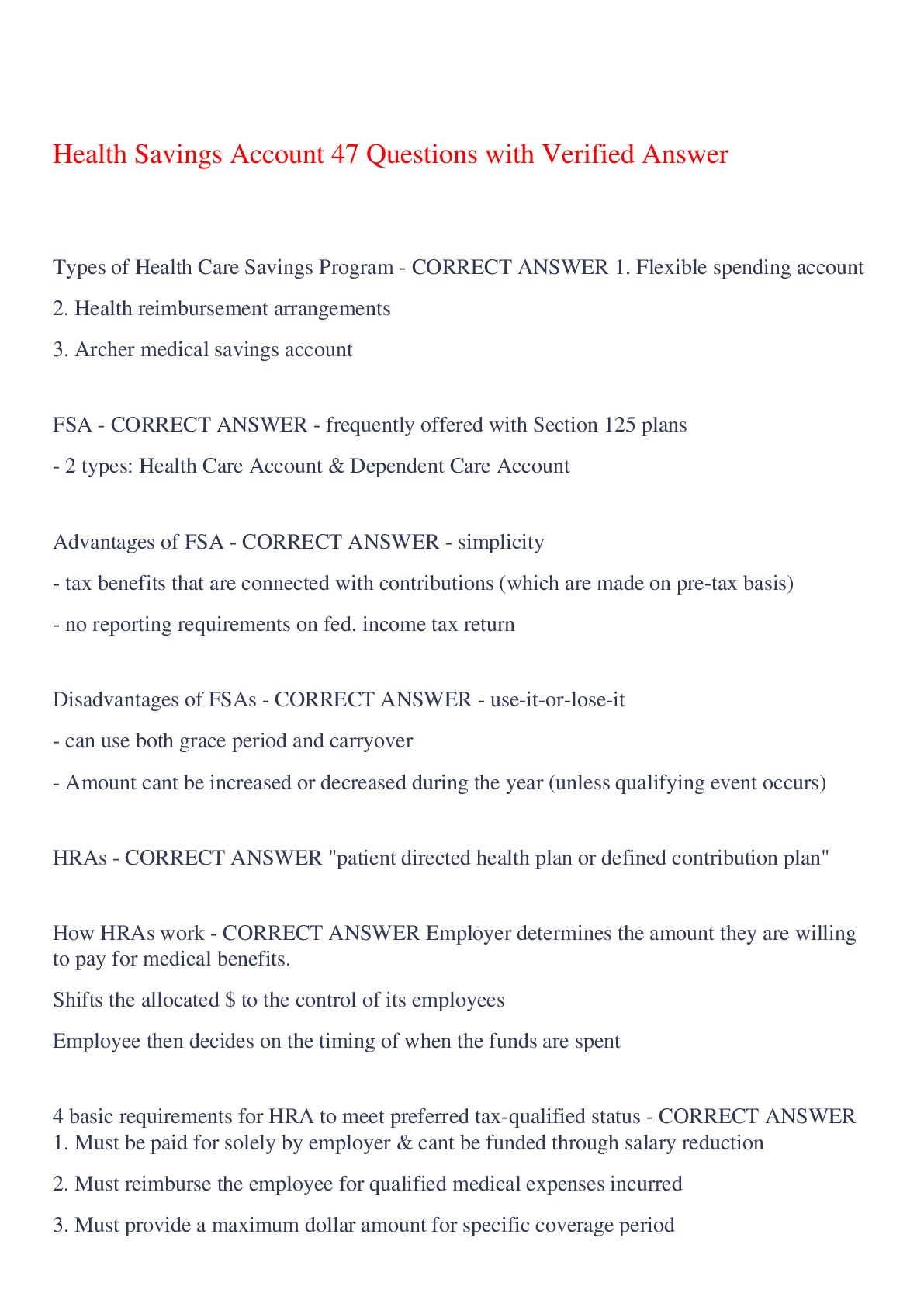








.png)





